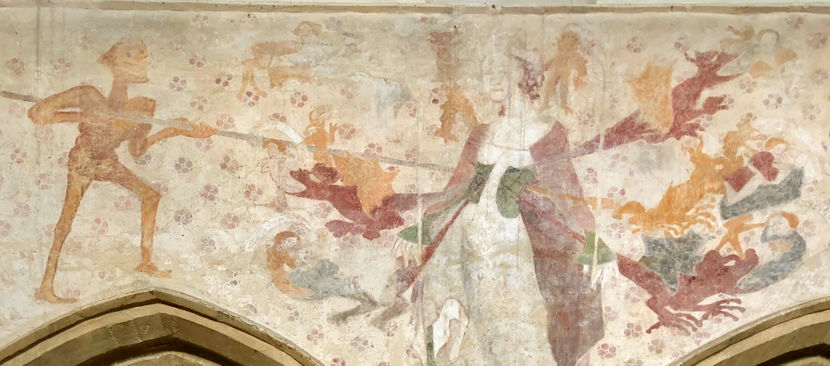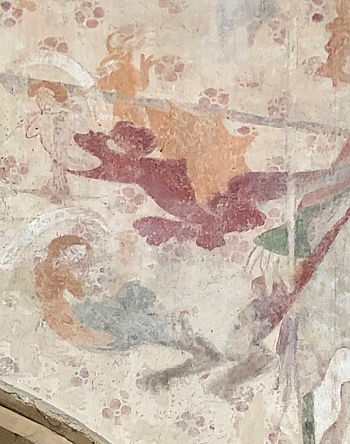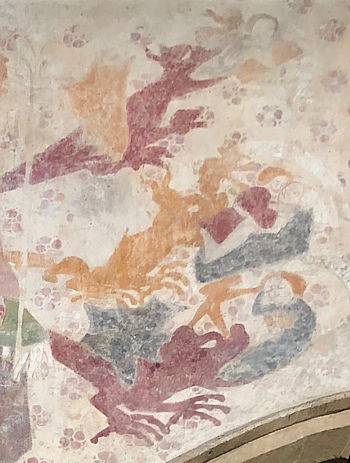Raunds, Northamptonshire (†Peterborough) C.15
The Seven Deadly Sins
“What is this womman,” quod I, “so worthili atired?”…¹


The central figure, a crowned and fashionably dressed woman, is not Piers Plowman’s Lady Mede, (although she has many interesting similarities) but a figure representing, probably, Pride, the first and most grievous Deadly Sin. From her, on either side, dragon-like creatures with claws vomit small figures representing the others, some of which can now be identified².
At the top left, close to the top edge of the painting is, almost certainly, Avarice (detail, left), very unclear now, but once accompanied by bags of money. Below this is Wrath, with blood cascading from self-inflicted wounds to the chest of the figure. A yellow devil in a typically triumphant pose stands nearby. The lowest figure has been identified as Envy, hands clasped to breast in bitter frustration. Like all the sin-figures, these have scrolls labelling them, all unreadable now but at least clearly visible in two cases on this side of the painting. Pride’s long, elegant fingers, delicately holding one of two sceptres³, also show quite well here.

To the right of the central figure (detail, right) are the three remaining sins. The one at the top was once thought to be Gluttony, on the grounds that a small animal, possibly a hog, once appeared beside it. I am very unsure about this identification, and I think this figure is more likely to be Sloth or ‘Accidie’, and the ‘hog’ perhaps a millstone or other heavy weight. Below, though, and much clearer, is Lust, with a recumbent man and woman embracing on a blue-green couch or bed. At the bottom the figure vomited by the dragon is, I think, Gluttony, holding its head and vomiting into a bowl even as it is itself vomited out. Gluttony with his bowl is a popular motif in medieval art of all kinds.
Pride, of course, must be seen to get her comeuppance in moralising art, and to the right of the Pride-figure (main picture) stands Death, shown as a grinning skeleton and stabbing Pride with a long lance, forcing the other Sins to issue from her. For this latter detail, the best comparison is with Alveley. Beneath Pride’s feet are the fires of Hell, with a figure burning inside, but this is very faint now.
Raunds has other paintings, including the Three Living & the Three Dead and a St Christopher also now on this site. There was once also a very full cycle of the Life of St Catherine in the north aisle, part of it also sketched in the article by Waller cited below. Only a few faint traces of it remain now.
¹William Langland, The Vision of Piers Plowman, Passus II, 19, B-text, ed. Schmidt, Everyman, 1995
²The first detailed commentary on this painting seems to be JG Waller, Archeological Journal, vol.34, 1877. Waller was apparently alerted to it by Sir Gilbert Scott, who had restored the church shortly before. Waller’s article includes a sketch of the painting.
³The twin sceptres may indicate sins of the mind and sins of the body, as Waller suggests, but there are various other possibilities – clergy and laity, men and women…
† in page heading = Diocese